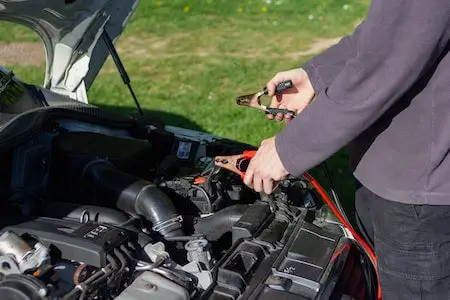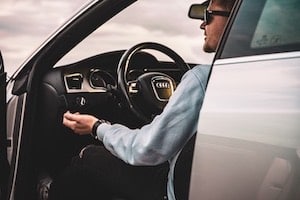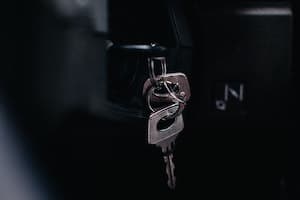Jump starting a car can be intimidating. Most people do not know how batteries and electricity work. This is something that you want to learn and do properly since car batteries are capable of producing high current that can cause serious injury. But when done properly, car batteries are safe and easy to deal with.
A common question is: Why do you connect the jumper cables to ground?
Do I have to connect the cable directly to the battery?
When jump starting a car, a solid connection to the chassis of the car is the same as a connection to the negative battery terminal and is often preferred to avoid any sparking generated near the battery.
“Ground” is the same as the car chassis.
It is common practice to connect the negative terminal of the charged car battery to the chassis of the car with the discharged battery. Many car batteries produce gases while being charged, and by connecting the cable away from the battery, reduces the risk of igniting the gases produced by the battery.
It is rare this type of accident happens but it is possible and can be avoided by connecting the jumper cables to the chassis rather than the battery.
Jump Starting Cable Connects to Chassis to Complete the Circuit
The battery is connected to the frame (ground) because that is what completes the circuit to promote the flow of electricity. Every component on the car is grounded to the frame and that is the path for the current to return to the battery.
When jump starting the car the cable is connected to “ground” and not directly to the (-) terminal of the battery because the (-) terminal is already connected to the chassis.
Many do this to avoid the chance of sparking close to the battery and although unlikely, the battery can explode from off gassing of hydrogen gas
When jumping a car, we connect the (+) end of the charged battery to the (+) end of the dead battery, and the (-) end of the charged battery to the chassis or other metal part of the car with the dead battery. Does this mean the circuit is open and why is that standard practice?
Difference Between “ground” and “common”
To state the obvious, ground is not referring to the ground that the car is parked on, but it is rather referring to the “current return common”
The (-) terminal clamp can be connected to the chassis because the chassis is used as the common path to ground for all the components on the car and the chassis is connected directly to the negative terminal of the battery.
Clamp to Chassis rather than battery to avoid possible explosion
The main reason to connect the jumper cables to the chassis rather than the battery terminal directly is to avoid any sparks created close to the battery. The discharged battery can produce gases such as hydrogen sulfide and since there is generally a brief arc as you complete the circuit to the live car’s battery, you definitely would rather this happened away from the battery!
Even though battery explosions are rare, they do happen and you can easily avoid this ever happening by clamping the ground battery to the chassis.
It would also be even safer to make the final connection of the jumper cables to the chassis of the car with the live battery. As far from the car with the dead battery as possible.
The Final Connection Jump Starting a Car
The (-) cable to the Car with the Live Battery Should be the Last Connection
It is best to connect the negative cable to the car with the live battery as the last or final connection so that you don’t have to lean, with a live wire, into the engine compartment or over the engine, to connect to the car battery.
when the battery terminal is easy to reach or at the front of the car it is perfectly fine to connect the jumper cable directly to the battery although it’s still is recommended to connect the negative terminal to the live battery as the final connection. This avoids making the final connection at a dead battery which could possibly emit combustible gases.
Proper Order To Connect Cables When Jump Starting a Car

The 6 Proper Steps to Jump Start a Car
- Ensure the Cables Are Separated and not touching
- Connect the (+) and (-) clamps to the battery terminals of the car with the charged battery
- Connect the (+) cable to the car with the dead battery
- Connect the (-) cable to the car with the dead battery onto the chassis
- Start the car with the live battery
- Wait 30 seconds then start the car with the dead battery
Why should the (+) clamp be connected first?
The (+) clamp is recommended to be connected first to avoid the possibility that it is connected to one battery and then the disconnected and falls down and touches anywhere on the chassis because this will cause a short circuit.
On the other hand if the clamp to the negative terminal accidentally falls and touches anywhere on the chassis of the second car it will not make a difference because the clamp is connected to ground and can touch anywhere on the chassis of the other car.
I generally do my best to avoid a short circuit from happening by simply laying the Cable ends on the ground that are to be connected second, then connect the first set of cables. Once I am ready to connect the second end of the cables to the car with a dead battery, I hold both cables – one in each hand at the same time and connect the positive cable followed immediately by the ground cable.
How the Battery Circuit Works On a Car
The chassis, and engine block all operate as the path to ground for the battery so that all components in the car can be connected to ground simply wherever they are straight to the chassis. The entire car is designed to work this way. Everything uses “earth return”. Call of the lights, spark plugs, etc. all ground to the frame of the car.
Why does the starter motor have a ground wire directly to the battery?
The starter motor requires a return wire directly to the battery negative terminal because it draws a lot of current and you would get a significant voltage drop if the frame of the car was used due to high resistance. To reduce the amount of resistance in the starter circuit a return wire is connected directly from the starter to the negative post on the battery.


